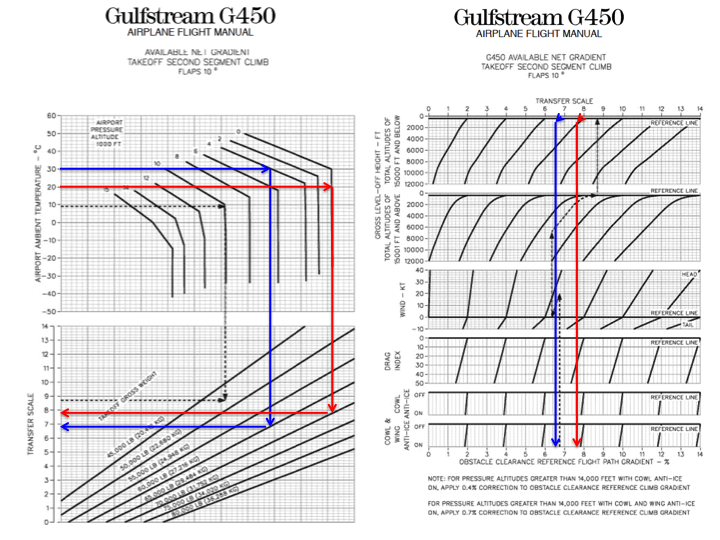Takeoff Flight Selection
- James Albright (a former G450 driver)
Updated: 2013-12-07
Every Gulfstream I've ever flown gives you two options for takeoff flap setting: 10° or 20°. The lower setting gives you a better climb but takes more runway, the higher setting gets you off the runway sooner at a cost of some climb performance. But big is the impact? Not so much in the G450 but it is a factor.
Everything here is from the references shown below, with a few comments in an alternate color.
Figure: Flap Selection, from Eddie's notes.
Runway Length Required
Figure: Effective Runway Length Required, from G450 Airplane Flight Manual, §5.2-11, 13
Generally speaking, if the aircraft has a choice of takeoff flap setting, a higher flap angle will reduce runway length required but will also reduce climb gradient. For example, in a G450 using two conditions:
Going from 10° flaps to 20° flaps reduced the effective runway length required by around 10% in our two example cases.
GWT. Temp P.A. 10° Flaps 20° Flaps
60,000 30°C 4,000' 5,500' 5,000'
65,000 20°C S.L. 4,750' 4,400'
Figure: Takeoff Second Segment Climb, 10° flaps, from G450 Airplane Flight Manual, §5.6-15.
Using the same conditions, looking at climb gradient for flaps 10°:
Figure: Takeoff Second Segment Climb, 20° flaps, from G450 Airplane Flight Manual, §5.6-13.
Using the same conditions, looking at climb gradient for flaps 20°.
Going from 10° flaps to 20° flaps reduced the climb gradient by around 15% in our two example cases.
GWT. Temp P.A. 10° Flaps 20° Flaps
60,000 30°C 4,000’ 6.6% 5.7%
65,000 20°C S.L. 7.7% 6.4%
References:
Gulfstream G450 Airplane Flight Manual, Revision 35, April 18, 2013





